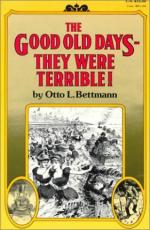
|
| Name: _________________________ | Period: ___________________ |
This test consists of 15 multiple choice questions and 5 short answer questions.
Multiple Choice Questions
1. What danger did many industrial laborers face in the latter part of the 19th century?
(a) Fire hazards.
(b) Lack of medical benefits.
(c) Unsafe working equipment.
(d) Toxic inhalants.
2. Traffic in the large American cities in the late 1800s was:
(a) Not too bad if you had a map.
(b) Light.
(c) Horrendous.
(d) Easy.
3. Where were the first apartments constructed?
(a) Chicago.
(b) Philadelphia.
(c) Los Angeles.
(d) New York City.
4. Why did tenants in the late 1800s have such big problems when it came to housing in the big cities?
(a) Landlords did not allow animals.
(b) They had no laws to protect them.
(c) There was too much housing to chose from.
(d) A lease was seldom renewed.
5. Before cars, what was the main source of transportation in the late 1800s?
(a) Horses.
(b) Walking.
(c) Bicycles.
(d) Subways.
6. Why was there such massive overcrowding on Manhattan Island in the late 1800s?
(a) Because of incoming immigrants.
(b) Because of the poor transportation.
(c) Because it was the only place to find work.
(d) People were too poor to leave the city.
7. Who were most of the shantytown residents in the late 1800s?
(a) African-Americans.
(b) Runaways.
(c) Newly-arrived immigrants.
(d) People displaced by their landlords.
8. In what decade was window screening introduced?
(a) 1890s.
(b) 1880s.
(c) 1870s.
(d) 1900s.
9. In the late 19th century, where was New York's shantytown?
(a) Near the railway station.
(b) Near the industrial neighborhood.
(c) On the outskirts of the city.
(d) Downtown.
10. According to "Rural Life," where were children most likely to be on the prairie?
(a) Boarding school.
(b) Physically working to help their parents.
(c) Playing games on the farm.
(d) At school.
11. When the railroads came to a town after the Civil War, where were they placed?
(a) They were run on the outskirts of town.
(b) They went straight through the towns.
(c) They were usually run through the industrial areas.
(d) They were placed a minimum of one mile from any residential area.
12. According to Bettmann in the chapter "Air," what did some people think air pollution was a good sign of?
(a) Luck.
(b) Wind currents.
(c) Industry.
(d) Health.
13. What major problem did window screening help with in the late 1800s?
(a) Light control.
(b) Privacy.
(c) Drafts.
(d) Insects.
14. According to Bettmann, what percentage of New Yorkers lived in the slums between 1868 and 1875?
(a) Fifty percent.
(b) Twenty-five percent.
(c) Thirty percent.
(d) Ten Percent.
15. According to Bettmann in "Housing," where did poorer residents end up who could not afford tenements?
(a) Sleeping at railway stations.
(b) Boarding homes.
(c) Homeless shelters.
(d) On the outskirts of the city.
Short Answer Questions
1. What kind of problem did the El Train have initially?
2. What did overpopulation in the big cities mean for the tenants in the late 1800s?
3. How were on-the-job accidents dealt with in the late 1800s?
4. What was the biggest safety threat in the vertical apartments in the late 1800s?
5. How many labor laws were there during the 19th century?
|
This section contains 517 words (approx. 2 pages at 300 words per page) |

|




